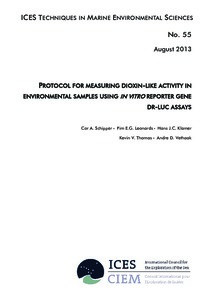Protocol for measuring dioxin-like activity in environmental sample using in vitro reporter gene dr-luc assays.

View/
Average rating
votes
Date
2013Author
Schipper, Cor A.
Leonards, Pim E. G.
Klamer, Hans J. C.
Thomas, Kevin V.
Vethaak, Andre D.
Status
PublishedPages
21pp.
Metadata
Show full item recordAbstract
Guidelines are given for the quantification of the dioxin-like activities of contaminants in sediment, biota and water samples using the DR-Luc reporter gene bioassay. Dioxins and dioxin-like compounds demonstrate high affinity binding to the Aryl hydrocarbon Receptor (AhR). Ah-R is a ligand-activated transcription factor and mediates most, if not all, of the toxic responses of polychlorinated dibenzo-p-dioxins (PCDDs), polychlorinated dibenzofurans (PCDFs), coplanar polychlorinated biphenyls (PCBs), and polybrominated biphenyls (PBBs). The DR-Luc bioassay, or DR-CALUX® (Dioxin Response Chemical Activated LUciferase gene eXpression), utilizes a recombinant rat hepatoma H4IIE cell line with a stably integrated AhR- responsive luciferase reporter gene. Exposure of this bioassay to extracts containing dioxin-like compounds induces the enzyme luciferase in a time, dose, and chemical specific manner. Cells are cultured in the laboratory and transferred to 96-well plates. Luciferase activity.....
Resource URL
http://ices.dk/publications/library/Publisher
International Council for the Exploration of the Sea (ICES)Copenhagen, Denmark
Series;Nr
ICES Techniques in Marine Environmental Sciences; 55Document Language
enSustainable Development Goals (SDG)
14.1Best Practice Type
Standard Operating ProcedureGuide
ISSN
0903–2606Citation
Schipper, C.A.; Leonards, P.E.G.; Klamer, H.J.C., Thomas, K.V. and Vethaak, A.D. (2013) Protocol for measuring dioxin-like activity in environmental samples using in vitro reporter gene DR-Luc assays. ICES Techniques in Marine Environmental Sciences, No. 55, 21pp. DOI: http://dx.doi.org/10.25607/OBP-264Collections
 Repository of community practices in Ocean Research, Applications and Data/Information Management
Repository of community practices in Ocean Research, Applications and Data/Information Management